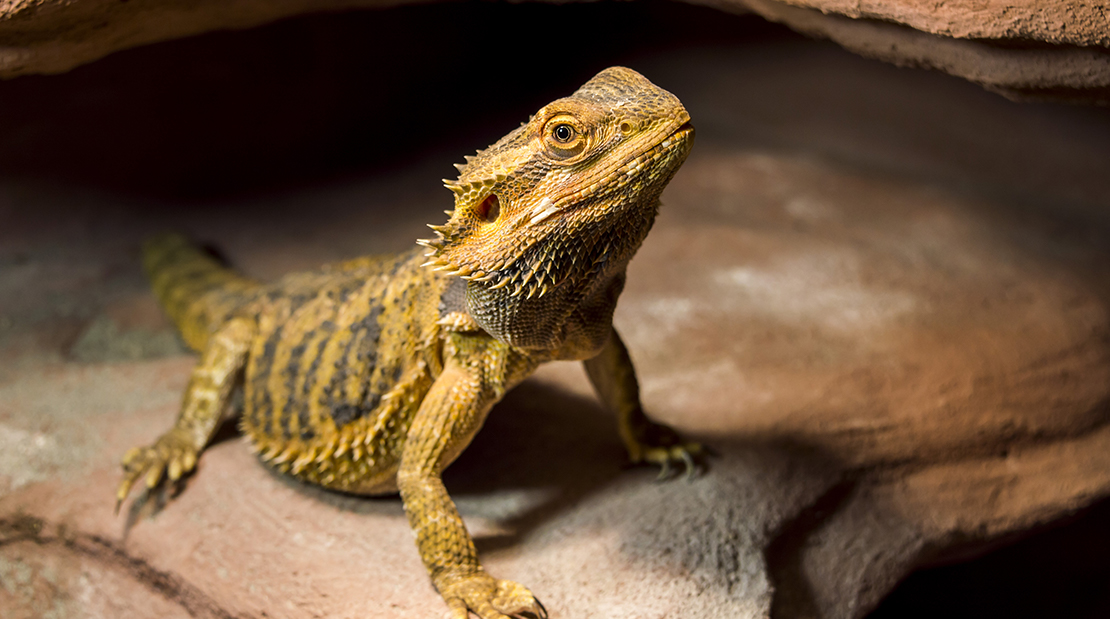
Living with a Lizard: How to Care for the Bearded Dragon
Lizards exist in more than 5,000 species, and live in a wide range of geographical regions around the world. For the lizard population to be so vast, only a small percentage are suitable for pet life. Even those that are fit to be household companions differ in temperament, dietary needs, and social compatibility.
A favorite among pet owners and veterinarians, is the Bearded Dragon Lizard. Bearded Dragons are native to Australia, and are great pets for both novel and experienced lizard owners. Bearded Dragons, affectionately called Beardies, have docile personalities, love attention, and are relatively low maintenance lizards. There’s no wonder why this species is frequently ranked as one of the best lizards to own. In fact, 80% of Cy-Fair lizard owners call the Bearded Dragon their pet.
Although the Bearded Dragon can be easier to handle than other lizards like Iguanas, they still require owners to be consistent in their routines, and aware of some basic practices that will help their Beardies live healthy and happy lives.
Bearded Dragons have different basic needs depending on its stage of life. Changes in how you care for your pet happens as your Bearded Dragon transitions from a juvenile to an adult.
First, let’s start with how to care for Bearded Dragons in its infancy stage.
Juvenile Bearded Dragons
Diet
Regardless of age, Bearded Dragons are omnivores, and eat insects, small animals, and plants. When Bearded Dragons are young, they need lots of protein, in addition to dark green veggies to help them grow. Their protein can come from sources like super worms or crickets. Plant based feedings can include vitamin rich food like collard and mustard greens. Food like Iceberg lettuce give little nutritional value, and is ineffective in providing the amount of vitamins your pet will need to thrive.
Calcium is particularly important because it helps Bearded Dragons develop strong bones and avoid conditions like Metabolic bone disease that can cause pathological fractures. Although young Beardies require high food intake, food should be portioned into several small meals, about 2-3 times a day.
Habitat
Bearded dragons are typically no more than four inches at birth, and naturally require less room than adults. Still, juveniles should have enough room to climb and hide as desired. Lizards are prey animals in their natural habitats, and instinctually seek places to take cover. Owners can place rocks or even holed flower pots in their Beardie’s tank to serve as hiding spots.
The tank should also include dual temperatures. Once side should be at an optimal temperature, between 80-90 degrees Fahrenheit. The other side should provide hot temperatures ranging from 95-110 degrees. Heat lamps can be used to provide the high temperatures.
The bedding of your pet’s tank should be made of lizard carpet or tile. Sand is often used for bedding, but not recommended. Lizards can consume the sand while eating their prey, which can lead to serious intestinal problems.
Lizards also need habitats that promote proper growth and healthy skin shedding. Sufficient hydration is a key component to maintaining good skin care. Owners can take several approaches to hydrating their pet. The first recommendation is to increase the tank’s humidity by placing a bowl of water on the hotter side of the tank, and allowing the water to eventually evaporate. Another method is to completely soak the lizard in water every one to two weeks. Towel dry your pet after the soak.
Misting should not be used as a method to hydrate Bearded Dragons. Unlike other lizards, misting this species can cause infections like Yellow Fungal Disease, and cause the skin to die and fall off.
Social Interaction
Socializing your Bearded Dragon at a young age will increase its tolerance and desire for human interaction and attention. This lizard doesn’t require tons of attention, with a once or twice a week handling being sufficient.
Adulthood
Diet
As the Bearded Dragon reaches adulthood, owners should decrease the amount of protein incorporated into the lizard’s diet. Beardies have low activity and spend a lot of time laying around at the bottom or side of their tanks.
Too much protein or fat can lead to obesity. At this stage, your pet’s protein should come from sources like Dubia Roaches. Adults should receive lots of plant based foods like collard greens, mustard greens, and spring mixes for sufficient vitamin intake. Adults should be fed about 3-5 times a week.
Habitat
Adult bearded dragons should be kept in tanks about 2-3 times its length from nose to tail. Adults share the same temperature, humidity, climbing, and hiding requirements as juveniles.
Socialization
If you began socializing your Bearded Dragon early on, it should be accustomed to, and even inviting to human interaction. Unlike other lizards, the Bearded Dragon loves attention and are less likely to bite or whip holders with its tail. If the lizard wasn’t handled as a juvenile, it’s not too late. Start by interacting with your pet once a week, and increase handling as time goes on. Some owners even sleep with their Bearded Dragons!
Overall, Bearded Dragon Lizards are exciting and interesting creatures to own. And now that you know the basics of how to care for your reptile companion, it’s beneficial to know the types of medical conditions Bearded Dragons can develop. Check out my follow-up post, Common Medical Conditions of Bearded Dragons. This blog will help you learn how to prevent or treat potential health threats, and ensure your new pet lives a long and happy life.

